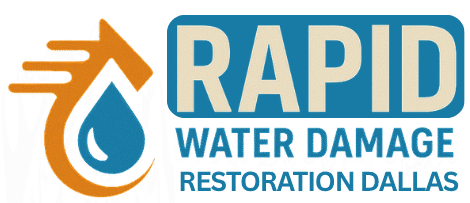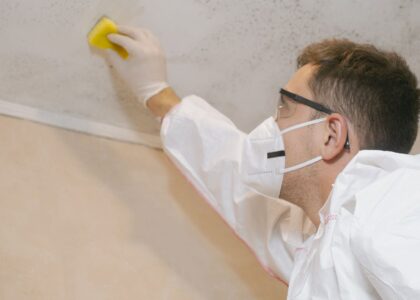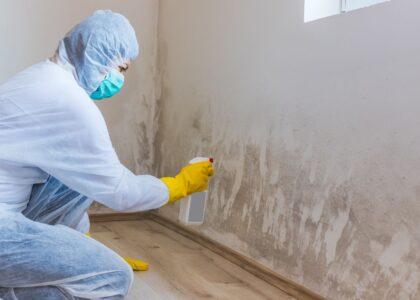Introduction
Mold is more than an aesthetic issue — it can affect your health, damage your property, and spread quietly behind walls. In this post, we’ll explore why mold remediation is essential, how mold grows, and what steps to take when you find mold in your home or business.
What Is Mold — And Why It Grows
Mold is a type of fungus that exists naturally in the environment. Tiny spores float in the air everywhere — indoors and outdoors. They become problematic when they land on a wet or damp surface inside buildings, find nourishment (wood, drywall, fabric), and begin to grow.
Key conditions for mold growth:
- Moisture or humidity (often > 60%)
- Organic materials (wood, drywall, wallpaper, paint, carpet)
- Poor ventilation or trapped air
- Water intrusion: leaks, floods, condensation
In places like Dallas, the humid climate, especially in summer months, can make interiors more vulnerable to mold growth if moisture control is not in place.
The Risks of Ignoring Mold
If you don’t act quickly, mold can lead to:
- Health issues: sneezing, coughing, itchy eyes, respiratory irritation, especially for allergy sufferers or people with weakened immune systems
- Structural damage: over time, mold degrades drywall, wood framing, and insulation
- Diminished indoor air quality: spores circulate through HVAC systems and throughout rooms
- Spreading infestations: once established, mold can quietly colonize hidden wall cavities, attics, and crawl spaces
Recognizing the signs early is key.
Signs You Might Have Mold
Even before calling a professional, watch for clues in your home:
- Persistent musty or earthy smell, especially in enclosed spaces
- Visible mold: black, green, white, or orange patches on walls, ceilings, floors
- Water stains, discoloration, peeling wallpaper or paint
- Bubbling or warping in wood or drywall
- Allergy-type symptoms indoors that worsen in certain rooms
If any of these appear, it’s time to evaluate more closely.
The Mold Remediation Process (What Professionals Do)
Mold remediation is not just cleaning — it’s a carefully controlled process to safely remove mold and prevent its return.
1. Inspection & Assessment
A trained technician inspects the property, locating mold growth and pinpointing the moisture source (leaks, humidity, condensation). Tools like moisture meters help detect hidden dampness.
2. Containment
To prevent spores from spreading during cleanup, containment barriers (plastic sheeting) and negative air machines are used.
3. Air Filtration
HEPA air scrubbers run continuously to capture airborne mold spores and reduce cross-contamination.
4. Removal & Cleaning
Porous materials (drywall, insulation, carpeting) that are heavily infested are removed and double-bagged. Non-porous surfaces (metal, glass) are cleaned with appropriate antimicrobial solutions.
5. Drying, Sanitization & Restoration
After mold removal, thorough drying using industrial dehumidifiers and air movers helps prevent recurrence. The area is sanitized, then repaired (painting, drywall, flooring) to restore it.
For more details, see our dedicated page on Mold Remediation.
Preventing Mold Return — Long-Term Strategies
Even after remediation, mold may return if you don’t control moisture. Here’s how to stay ahead:
- Monitor humidity levels — keep indoor relative humidity under ~60% (ideally 30–50%)
- Ventilation — use exhaust fans in bathrooms, kitchens, laundry areas
- Fix leaks fast — plumbing, roofing, foundation cracks must be addressed immediately
- Dry wet areas promptly — after flooding or leaks, dry surfaces within 24–48 hours
- Improve airflow — avoid crowding walls and furniture, ensure ducts and vents aren’t blocked
- Gutter & drainage upkeep — make sure water is directed away from foundations
These practices reduce the chance of mold reestablishing itself.
When to Call the Professionals (and What to Ask)
While small mold patches might tempt DIY cleaning, there are times when professional remediation is safer and more effective:
- Mold growth covers large areas (e.g. > 10 square feet)
- Mold is hidden behind walls or in HVAC systems
- Your home has multiple moisture issues
- There’s a history of recurring mold
If you need help, explore our Contact Us page for guidance and to schedule service.
Conclusion
Mold may start small, but left unchecked it poses risks to health and your property. Understanding how mold grows, recognizing early signs, and knowing the professional remediation process empowers you to act. And once mold is removed, maintaining moisture control is your best defense against its return.
For a deeper dive into the remediation process, visit our Mold Remediation page. If you’re ready to take action or want to schedule an evaluation, head to our Contact Us page today.



